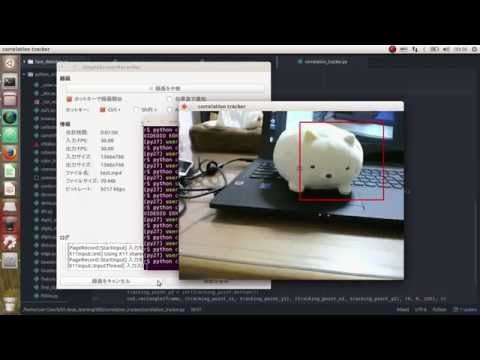OpneCVの物体追跡はちょくちょくサンプルを動かしたことがあるのだけど、
dlibは動かしたことがなかったため、ちょっとお試し。
モーションブラーとかにも付いて行ってて、結構性能良さそうな感じ。
動画は以下。
https://www.youtube.com/watch?v=ORgMddcNHvU

ソースコードは以下。
#!/usr/bin/env python
# -*- coding: utf-8 -*-
'''
correlation_tracker.py.
Usage:
correlation_tracker.py [<video source>] [<resize rate>]
'''
import sys
import dlib
import cv2
import time
import copy
# マウスイベントハンドラ
mouse_start_x, mouse_start_y = 0, 0
mouse_end_x, mouse_end_y = 0, 0
selecting = False
tracker_start_flag = False
tracking_flag = False
def select_roi(event,x,y,flags,param):
global selecting, tracker_start_flag
global mouse_start_x, mouse_start_y
global mouse_end_x, mouse_end_y
if event == cv2.EVENT_LBUTTONDOWN:
selecting = True
mouse_start_x, mouse_start_y = x,y
elif event == cv2.EVENT_MOUSEMOVE:
if selecting == True:
mouse_end_x, mouse_end_y = x, y
else:
pass
elif event == cv2.EVENT_LBUTTONUP:
mouse_end_x, mouse_end_y = x, y
selecting = False
tracker_start_flag = True
# 引数解釈
try:
fn = sys.argv[1]
if fn.isdigit() == True:
fn = int(fn)
except:
fn = 0
try:
resize_rate = sys.argv[2]
resize_rate = int(resize_rate)
except:
resize_rate = 1
# トラッカー生成
tracker = dlib.correlation_tracker()
video_input = cv2.VideoCapture(fn)
if (video_input.isOpened() == True):
ret, frame = video_input.read()
cv2.imshow('correlation tracker', frame)
cv2.setMouseCallback('correlation tracker', select_roi)
while(video_input.isOpened() == True):
ret, frame = video_input.read()
temp_frame = copy.deepcopy(frame)
# 処理負荷軽減のための対象フレーム縮小(引数指定時)
height, width = frame.shape[:2]
temp_frame = cv2.resize(frame, (int(width/resize_rate), int(height/resize_rate)))
if tracker_start_flag == True:
# 追跡開始
tracker.start_track(temp_frame, dlib.rectangle(mouse_start_x, mouse_start_y, mouse_end_x, mouse_end_y))
tracking_flag = True
tracker_start_flag = False
elif tracking_flag == True:
# 追跡更新
tracker.update(temp_frame)
# 描画
if selecting == True:
cv2.rectangle(frame, (mouse_start_x, mouse_start_y), (mouse_end_x, mouse_end_y), (0, 0, 255), 2)
if tracking_flag == True:
tracking_point = tracker.get_position()
tracking_point_x1 = int(tracking_point.left())
tracking_point_y1 = int(tracking_point.top())
tracking_point_x2 = int(tracking_point.right())
tracking_point_y2 = int(tracking_point.bottom())
cv2.rectangle(frame, (tracking_point_x1, tracking_point_y1), (tracking_point_x2, tracking_point_y2), (0, 0, 255), 2)
cv2.imshow('correlation tracker', frame)
c = cv2.waitKey(50) & 0xFF
if c==27: # ESC
break
以上。